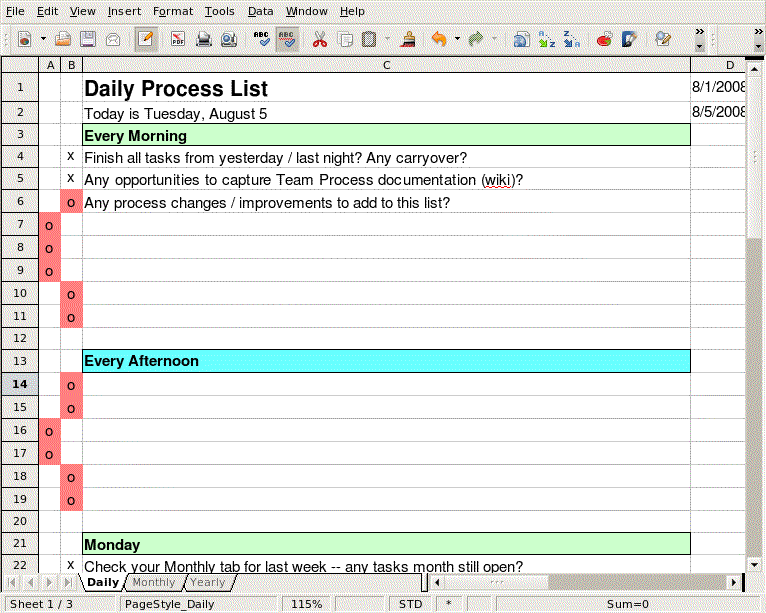If you need a one-slide, three-bullet, PowerPoint special for describing the basic tactics for “How to Achieve Operational Excellence”, try these:
- Process and Procedures
- Metrics and Measurements
- Continuous Improvement
The first two are nicely alliterative, but you might consider substituting Standards and Processes as your lead-off if we’re talking about an IT, Finance, or Engineering department.
Now What?
Of course, now you have to generate the details; the “motherhood and apple pie” routine only lasts thru the first meeting. Here’s where many organizations discover that it’s hard to know where to start. Most people find a blank sheet of paper intimidating; they prefer editing to creating. Also, folks are easily overcome by the volume and complexity of all of the processes they go through every day.
<aside>And for some reason, people seem to gravitate to the most difficult thing to document – “experience”. It’s like whistling – hard to describe on paper, but easy to demonstrate, with multiple variations and endless complexities. How can I possibly convey my thought processes when I’m debugging a system, triaging a set of problems, or pulling together those first few critical design elements?
Well okay then – let’s not think about that right now. We’ll talk ourselves out of any process documentation before we even start!</aside>
Start Simple
For every job, there is a recurring list of “stuff” that folks do every day – administrative and busywork tasks that must be done, just to keep the wheels turning. This is the kind of “process” that lends itself very easily to documentation (and, afterwards, automation, but that’s another post). It’s the little things that you do, unnoticed until you take a vacation day or call in sick. All of a sudden, things stop working or start breaking, because you weren’t there to reboot the server first thing in the morning, or clear a cache, or check a job queue for stuck items …
So a great place for your team to start is to build a ToDo list of repeating tasks. It can be a simple text file, a Word document with nice formatting, a spreadsheet with convenient rows and columns – it really doesn’t matter. My personal favorite is the spreadsheet – I use tabs to break up the lists into nice sized chunks …

I’ve posted a few simple files on my Source Code page:
- Recurring Tasks01.txt – Text File – easy to convert to your wiki!
- Recurring Tasks02.ods – OpenOffice Spreadsheet, with sample tasks
- Recurring Tasks03.xls – (Excel version, saved from Open Office)
There are some nice features in the spreadsheets – like color coding for when a task is done (x) or undone (o). Also, the current day, week, month are highlighted automatically.
Collaboration Suggestion
If this idea makes sense, consider skipping the documents / spreadsheets, and create this as a wiki page (or collection of pages). Then, the entire group can add their recurring tasks – and the group will develop a shared master list. This makes it much easier to encourage shared tasks, standardization of work, etc.
- Note: Does this structure remind you of 43 Folders and Getting Things Done? Well, that’s definitely in the ballpark, but GTD focuses more on personal productivity. Daily / Weekly / Monthly Process Lists add structure and enhance productivity for a group. If you can scale the ideas in David Allen’s book to help an entire group – and make it easy for folks to join and leave the group – go for it!
Some Task List Best Practices
- Tasks on the lists should be one-liners. “Reboot the Server” or “Empty a Job Queue” are great, but if a single task actually has a series of process steps involved, best make that a separate, more detailed task list
- Continuous improvement and ongoing documentation are themselves recurring tasks; consider putting a task to start each day thinking about items that are on your plate today that could/should make this list
- The sample spreadsheet features the color-coded “checkmarks” that indicate when a task is complete. If you use a wiki (like TiddlyWiki), there may be plug-ins / extensions (like this one) that allow you to put checkboxes in the wiki itself. Checking the box when something is complete makes you think through each process step-by-step; if you just scan the lines every day, it’s easy to slough them off. Plus, it’s psychologically satisfying to see all those unchecked items get crossed off the list!





Comments (0)